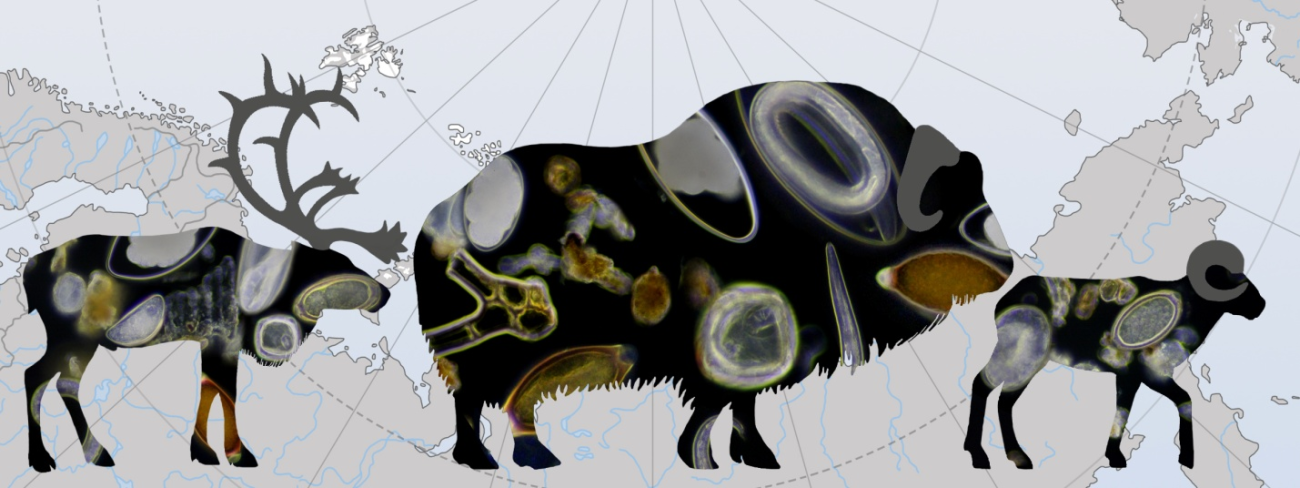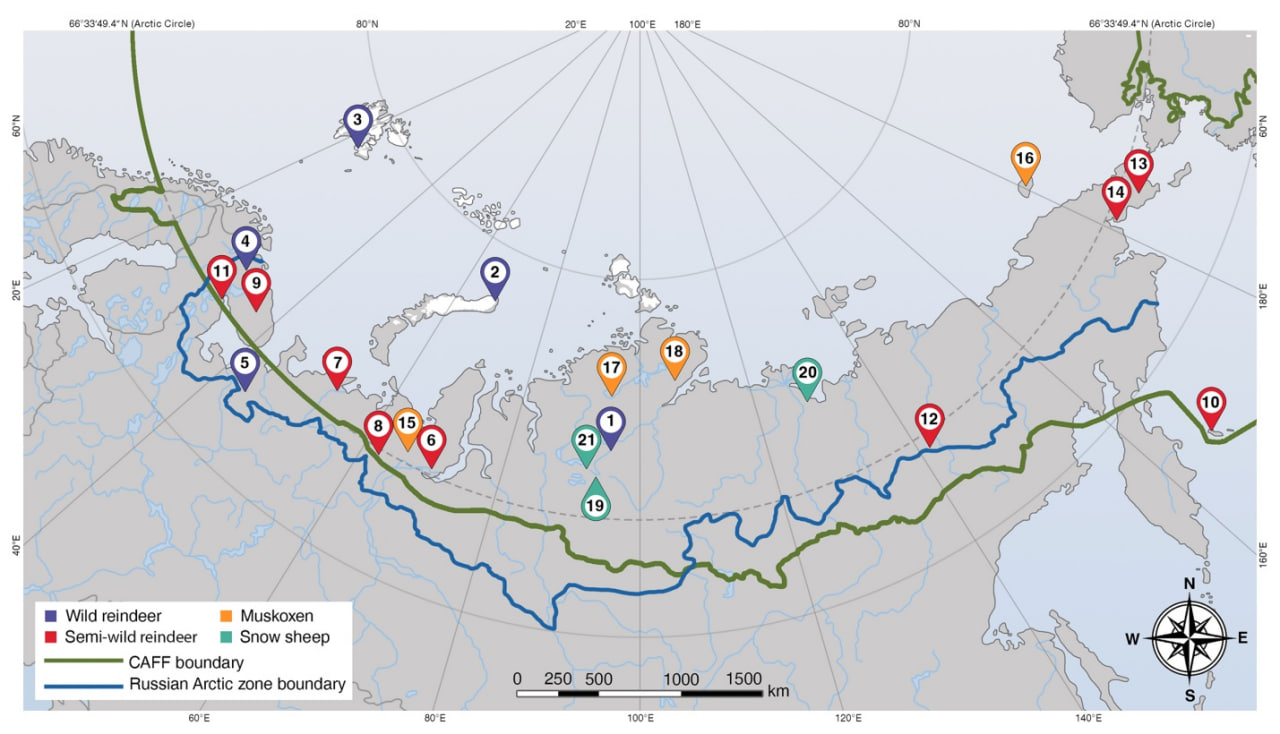
A team of Russian parasitologists and theriologists studied the species diversity and distribution of helminths of wild and semi-wild reindeer (Rangifer tarandus), musk ox (Ovibos moschatus) and bighorn sheep (Ovis nivicola) in the Russian Arctic.
The helminth fauna of reindeer and bighorn sheep was previously studied about 60 years ago. Moreover, the deer were mostly domestic. And, of course, in those years molecular phylogenetic methods had not yet been developed. The musk ox was introduced in the 70s from North America, and its helminths were not studied in Russia at all. Considering the active development of the Arctic coupled with climate change, it was very important to obtain reference data for the current moment.
Researchers collected 519 samples of ruminant feces in the north of the Palaearctic: in the Arkhangelsk and Murmansk regions (including the Novaya Zemlya archipelago), in the republics of Karelia and Sakha, on the Kola, Yamal, Taimyr and Chukotka peninsulas, on the Bering, Wrangel and Spitsbergen islands (Norway). The latter was included for comparison on the basis of the Spitsbergen Treaty, which granted Russia the right to exploit natural resources and the actual presence of our country on the archipelago.

The Center for Parasitology of the Institute of Ecology and Evolution of the Russian Academy of Sciences conducted a helminth-coprological study to identify eggs and larvae of helminths of the digestive, respiratory, nervous and muscular systems. Parasites were identified based on morphological and morphometric data and analysis of nucleotide sequences. The extent and intensity of the invasion were established.
Two genera of trematodes (Paramphistomum and Dicrocoelium), one genus of cestodes (Moniezia) and various nematodes were found in reindeer: small gastrointestinal nematodes, Marshallagia sp., Nematodirus spp. (three different morphotypes), Nematodirella sp. (including N. longissimespiculata), Skrjabinema tarandi, Trichuris sp., Capillaria spp., Ascaris mosgovoyi, Dictyocaulus sp., Elaphostrongylus rangiferi, Orthostrongylus macrotis and Varestrongylus eleguneniensis. A photograph of an A. mosgovoyi egg is presented for the first time. V. eleguneniensis has not previously been found in the Palearctic. This is also the first report of O. macrotis in reindeer.
No trematodes were found in muskox, but one genus of cestodes (Moniezia) and various nematodes (small gastrointestinal nematodes, Nematodirus sp., Nematodirella sp., Trichuris sp., larvae from the family Protostrongylidae) were found.
No trematodes were found in bighorn sheep, but one genus of cestodes (Moniezia) and various nematodes (small gastrointestinal nematodes, Marshallagia sp., Nematodirus sp., Trichuris sp., capillary nematode and various morphotypes of Protostrongylus) were found. Capillary-like nematodes have not previously been found in bighorn sheep.
With the exception of one case with a deer from a private zoo, in all examined ruminants the intensity of invasion was low, which indicates a satisfactory immune status of the animals.
The habitats of bighorn sheep are quite isolated, but introduced musk oxen are in sympatry with reindeer. The authors consider introduced species as a possible reason for the discovery of North American parasites in native reindeer.
In addition to true parasites, false (spurious) and pseudoparasites were found in feces. Among them were bdelloid rotifers at various stages of development. In dried fecal samples, they came to life after adding water. Rotifers may have contaminated feces after excretion (as the material was often picked up from the ground). Or they were accidentally ingested and managed to survive inside the ruminants. To the authors' knowledge, Arctic ruminants have never been implicated as hosts of rotifers. Given that reindeer travel long distances every day, they may play an important role in the spread of rotifers.

O. A. Loginova, S. B. Rosenfeld, T. P. Sipko and S. E. Spiridonov participated in the work from the IEE RAS. The article was published in a special issue of the journal “Diversity” (Q1) “Biodiversity of Parasites in Vertebrates in the Wildlife” in open access mode. https://www.mdpi.com/1424-2818/15/5/672
Loginova, Olga A., Sofya B. Rozenfeld, Taras P. Sipko, Ivan A. Mizin, Danila V. Panchenko, Kasim A. Laishev, Mikhail G. Bondar, Leonid A. Kolpashchikov, Aleksandr R. Gruzdev, Pavel S. Kulemeev, Dennis I. Litovka, Mariia N. Semerikova, Viktor N. Mamontov, Evgeniy G. Mamaev, and Sergei E. Spiridonov. 2023. "Diversity and Distribution of Helminths in Wild Ruminants of the Russian Arctic: Reindeer (Rangifer tarandus), Muskoxen (Ovibos moschatus), and Snow Sheep (Ovis nivicola)" Diversity 15, no. 5: 672. https://doi.org/10.3390/d15050672
Related materials:
Ministry of Education and Science: "Scientists have identified new parasites in ruminants in the Arctic and Spitsbergen"
RAS: "New parasites in ruminants in the Arctic and Spitsbergen"
Comfort-sr: "Scientists have identified new parasites in ruminants in the Arctic and Spitsbergen"
Ferra.ru: “Russian scientists have found worms unknown to science among Arctic ruminants”
Glas Naroda: "New parasites found in ruminants in the Russian Arctic and Spitsbergen"
Rambler: "Scientists from Russia have found worms unknown to science among Arctic ruminants"
Arguments and facts: “Unusual types of worms were found in reindeer”
PC-problems: "Scientists from Russia found worms unknown to science among Arctic ruminants"
Science and Life: “The parasites of Russian reindeer have been counted”
Club-TM: “Scientists from Russia found worms unknown to science among Arctic ruminants”
Day-inews: “Russian scientists have found worms unknown to science among Arctic ruminants”
Vesti1: "Unusual types of worms were found in reindeer"
Tnaneve.spb: “Scientists from Russia found worms unknown to science among Arctic ruminants”
